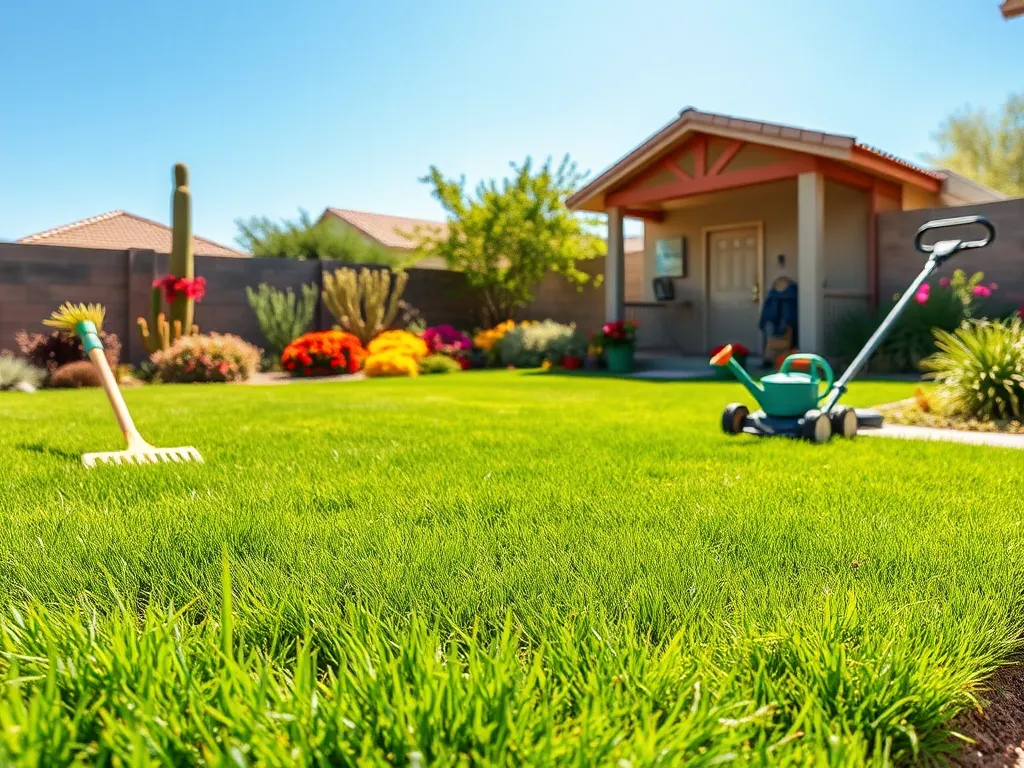
Seasonal Lawn Care for Phoenix Homeowners
Seasonal Lawn Care for Phoenix Homeowners is essential for maintaining a vibrant and lush lawn throughout the year. Given the unique climate of Phoenix, understanding the seasonal changes and how they impact your lawn care routine can make all the difference in achieving a healthy yard.
As the heat intensifies in Phoenix, homeowners need to adapt their lawn care practices accordingly. This requires a strategic approach that encompasses everything from selecting the right grass types to implementing effective watering schedules, pest control measures, and fertilization techniques. With the right knowledge and practices, seasonal lawn care can transform your green space into an oasis.
Throughout the year, each season presents its own set of challenges and tasks that homeowners must navigate. From the blooming growth of spring, the scorching heat of summer, the preparation for dormancy in fall, to the cold winter months, every homeowner can benefit from a detailed plan for lawn care that suits the Phoenix climate. This article aims to provide insights on effective seasonal lawn care for Phoenix homeowners.
With various grass types suited for different seasons, it is crucial to select the appropriate species that thrive in the Phoenix climate. Homeowners should also be aware of local pests that can affect the lawn, as well as the best fertilization and irrigation techniques to ensure optimal growth. This comprehensive guide will help you understand the seasonal changes and prepare your lawn accordingly.
Homeowners in arid regions can greatly benefit from following these desert climate lawn tips.
Ultimately, Seasonal Lawn Care for Phoenix Homeowners is about being proactive rather than reactive. By following the right lawn care practices throughout the year, you can preserve the beauty of your lawn and enjoy a lush outdoor space to relax and entertain.
Spring Lawn Care
Spring in Phoenix is the perfect time to rejuvenate your lawn, especially with warm-season grasses such as Bermuda, Zoysia, and Fescue. These grasses thrive with the warmer temperatures and can handle the summer heat that follows. Homeowners should focus on ensuring that the selected grass type is well-established before the peak heat of summer.
A seasonal gardening calendar can be invaluable for planning your planting strategy throughout the year.
Fertilization during the spring is crucial for robust growth. Applying a nitrogen-rich fertilizer can promote a healthy lawn that will flourish during the summer months. It’s also advisable to perform a soil test to determine nutrient levels and make necessary adjustments accordingly.
For those seeking advice on year-round lawn maintenance, finding a reliable source is crucial.
Irrigation is a significant factor in spring lawn care. As temperatures begin to rise, focusing on deep watering practices—ideally early in the morning—ensures that the roots absorb moisture effectively. Homeowners should aim to water deeply but less frequently to encourage deeper root growth.
Weed control strategies in the spring involve both pre-emergent and post-emergent herbicides. Pre-emergent herbicides prevent seeds from germinating, while post-emergent herbicides eliminate existing weeds. Homeowners should apply these treatments carefully, following product instructions to effectively manage their lawn’s health.
Aeration and overseeding are essential methods in the spring. Aeration helps relieve soil compaction, allowing air, water, and nutrients to penetrate deeper into the soil. Overseeding with high-quality grass seed will fill in thin areas and promote a lush lawn that can handle summer heat effectively.
Summer Lawn Maintenance
During the summer months, heat-tolerant grass species such as Bermuda and Zoysia are ideal for Phoenix lawns. These grasses can withstand high temperatures and are resilient during periods of drought, making them a favorite for homeowners looking to conserve water.
Irrigation schedules should be adjusted in the summer, with homeowners typically watering in the early mornings or late evenings to minimize evaporation. It’s essential to provide sufficient water—1 to 1.5 inches per week—to keep the lawn healthy and green.
Managing lawn pests during summer can pose a challenge, as heat often brings out various insects. Regularly inspect your lawn for signs of pests and apply appropriate treatments, ensuring to follow environmentally friendly practices whenever possible.
Mowing techniques in summer should involve setting the mower blades higher, as longer grass provides shade to the root systems and helps retain moisture. Aim to mow just a third of the grass blade at a time to prevent stress on the lawn.
Applying mulch around garden beds can help retain water in the soil during hot summer months, reducing the frequency of watering. It also aids in suppressing weeds and maintaining a consistent temperature for the roots.
Fall Lawn Preparation
As fall approaches, it’s essential to prepare your lawn for winter dormancy. This includes reducing the frequency of mowing and allowing grass to grow slightly taller to protect the roots from colder temperatures. A lush lawn going into winter can also help reduce weed issues.
Fall fertilization techniques focus on applying a slow-release fertilizer to give the lawn nutrients that will support it during dormancy and into the spring. Be mindful of the timing to ensure that the fertilizer is absorbed before the first frost.
Seeding and sodding can be beneficial in the fall, particularly for addressing any bare spots that emerged during the hot summer. This is also an excellent time to consider transitioning to cool-season grasses suitable for the transitional zones that may surround the lawns.
Weed prevention tactics in the fall involve applying pre-emergent herbicides to prevent winter weeds from germinating. Homeowners should also manually remove any existing weeds to reduce competition for nutrients during the dormant season.
Drainage solutions for fall rains are essential to prevent water from pooling on the lawn, which can lead to diseases. Adjusting soil gradient and using drainage systems can help direct excess rainwater away from the lawn effectively.
Winter Lawn Care
Winterizing your lawn is critical, particularly in a region like Phoenix where winters can be mild yet still detrimental to grass types. Homeowners should implement a final fertilization in late fall, focus on hydration, and ensure proper mowing to maintain a healthy lawn going into winter.
Choosing the right winter cover crop can provide additional benefits, including preventing soil erosion, improving soil health, and adding nutrients back into the soil when tilled. Cover crops such as clover or vetch can enrich your lawn’s ecosystem during dormancy.
Maintaining lawn equipment during winter is just as crucial. Regular cleaning, lubricating, and sharpening of blades can enhance performance for the next mowing season and extend the life of your equipment.
Identifying lawn issues in winter months involves vigilant monitoring of your lawn. Look for discoloration or unusual growth patterns, as these can be indicative of pests or diseases that need addressing before spring arrives.
Finally, preparing your lawn for spring growth involves a simple clean-up, such as raking leaves and removing debris that may inhibit growth as spring approaches. Conducting a soil test early in the year will also prepare you for effective fertilization and care moves in the coming months.
